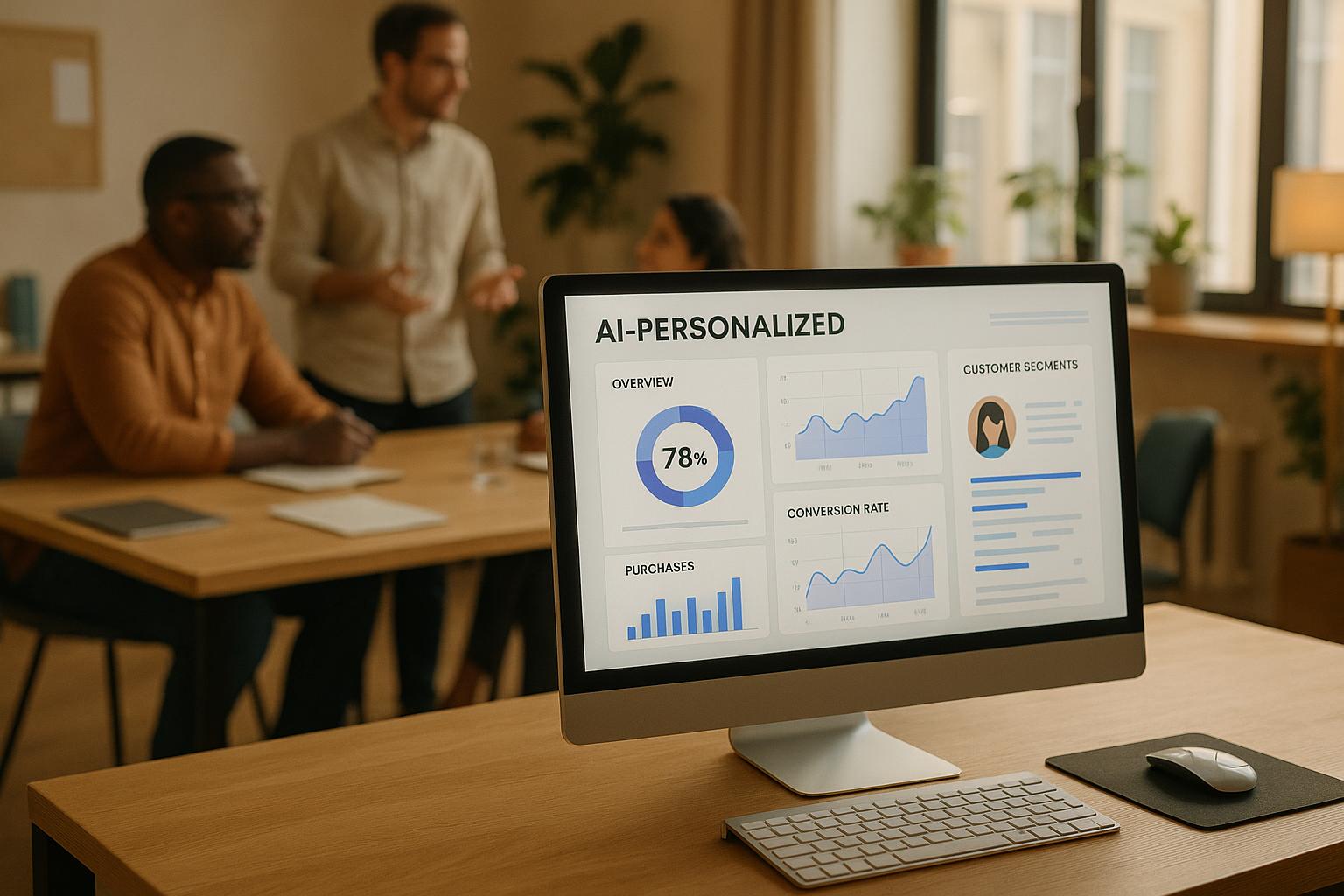White-label AI solutions let agencies offer advanced, branded AI tools without building them from scratch. These pre-built solutions save time, reduce costs, and help agencies scale services quickly while keeping their brand front and center. Here's what you need to know:
- What They Are: Pre-built AI tools you can rebrand and integrate into your services.
- Why They Matter: Offer faster setup, affordable scaling, and improved client results.
-
Key Features to Look For:
- Customization (logos, branding, messaging)
- Seamless integration with CRMs and APIs
- Analytics for performance tracking
- Multilingual support for global reach
-
Examples:
- Stammer.ai: Chatbots and lead generation for marketing agencies.
- Vendasta: SEO and reputation management for full-service agencies.
- My AI Front Desk: AI-powered virtual receptionist offering.
White-label AI tools help agencies meet client demands, deliver tailored solutions, and scale efficiently, making them essential for staying competitive in a fast-changing market.
9 Best White Label AI Software Tools 2024
Choosing the Right AI Tools for White-Labeling
Selecting the right white-label AI platform is a crucial step in delivering high-quality services, scaling effectively, and ensuring client satisfaction. Your choice will shape how well your agency can meet client needs and adapt to market demands.
Features to Look For
When comparing white-label AI platforms, focus on features that enhance customization, integrate smoothly with existing systems, provide detailed analytics, and support multilingual operations. These elements are key to offering efficient and scalable services.
- Customization and Branding: Opt for platforms that let you customize the interface, add your logo, and tailor messaging to match your agency's branding. This ensures a consistent look and feel for your services.
- Seamless Integration: Look for tools that work effortlessly with CRMs, APIs, and essential marketing software. This makes it easier to fit into your clients' existing workflows.
- Analytics and Reporting: Platforms like Vendasta offer advanced analytics to monitor performance and clearly show ROI to your clients.
- Multilingual Functionality: If you're working with global markets, choose platforms that support multiple languages. This ensures smooth communication and service delivery for diverse audiences.
Examples of White-Label AI Platforms
Here are some platforms that provide white-label AI solutions tailored to different industries:
| Platform | Features | Best For |
|---|---|---|
| InnovaAI | Chatbots, lead generation, multilingual campaigns | Digital marketing agencies |
| Vendasta | Reputation management, SEO, analytics | Full-service agencies |
| Stitch Fix | Personalized recommendations for e-commerce | E-commerce agencies |
For instance, Stitch Fix uses white-label AI to offer personalized clothing recommendations. Their system analyzes customer input and feedback to deliver tailored suggestions, showcasing how specialized AI can drive customer satisfaction.
Once you've picked a platform, the next step is customizing it to align with your agency's branding and goals. This ensures your services stand out in a competitive market.
Customizing and Branding AI Solutions
Customizing and branding AI tools can strengthen your agency's identity while boosting client trust and satisfaction. It’s a smart way to set the stage for long-term success.
Customization Strategies
Start with the user interface - adjust colors, typography, and layouts to match your agency’s brand. Platforms like InnovaAI let agencies tweak dashboards, navigation menus, and report templates, ensuring your branding stays front and center.
Another key step is data integration. Feeding AI tools with client-specific data - like brand values, tone, and historical performance - enables tailored solutions. For example, using this data can help create highly personalized marketing campaigns that resonate with your client’s audience.
Branding Best Practices
Building trust and recognition requires consistent branding across all client touchpoints. Here's how agencies achieve this:
| Branding Element | Implementation Strategy | Impact |
|---|---|---|
| Visual Identity | Customize UI elements, logos, and color schemes | Builds immediate brand recognition |
| Voice and Tone | Align AI-generated content with your agency's brand voice | Maintains a consistent brand persona |
| Reporting Format | Standardize dashboards and client reports | Enhances professional presentation |
Take Vendasta as an example. Their platform allows agencies to integrate AI tools seamlessly while keeping branding consistent across client-facing materials. One standout feature is their review management software, which helps agencies track and improve clients’ online reputations - all while maintaining cohesive branding throughout the customer journey.
Once your AI solutions reflect your brand identity, the next step is to ensure they fit smoothly into your clients' workflows.
Integrating AI Solutions into Client Workflows
Bringing white-label AI tools into your clients' workflows requires a structured approach to ensure everything runs smoothly. Here's a breakdown of how to integrate these tools effectively into existing systems.
Steps for Integration
- Assessment and Planning: Start by auditing the client's systems, software, and team capabilities. This helps identify what’s needed for a successful integration. With many businesses already using AI, this step is often easier than it used to be.
- Data Integration: Connect client data to ensure the AI tool delivers personalized results and works seamlessly across platforms.
- Testing: Before going live, run a pilot program to catch and fix any issues.
- Deployment: Train the client's team, roll out the solution, and keep an eye on adoption rates to ensure everything is on track.
| Integration Phase | Key Activities | Success Metrics |
|---|---|---|
| Assessment | System audit, requirement gathering | Compatibility score |
| Setup | Data integration, customization | Integration completion rate |
| Testing | Pilot program, user feedback | Error reduction percentage |
| Deployment | Staff training, full rollout | Adoption rate |
Examples of Successful Integrations
Here are some real-world examples of how agencies have used AI integration to drive results:
- Marketing Agency Example: A digital marketing agency introduced white-label AI chatbots, increasing lead generation by 30%. This was achieved through thorough staff training and clear communication with clients.
- E-commerce Integration: An online retailer implemented AI-powered recommendation engines, leading to a 20% boost in sales by tailoring shopping experiences to individual users.
- Financial Services Case Study: A banking institution deployed a white-label AI fraud detection system, cutting fraudulent transactions by 40% through careful integration with security protocols.
To maintain success after integration:
- Regularly track metrics like adoption rates, error rates, and ROI.
- Gather and act on client feedback.
- Continuously update and improve AI models based on performance data.
"When you offer AI integration services, you make it possible for your clients to do the same."
With the right integration strategy, agencies can use white-label AI to grow their services and help clients achieve their goals.
Scaling Your Agency with White-Label AI Solutions
How White-Label AI Helps Agencies Grow
White-label AI allows agencies to expand their services without a big jump in costs. By automating repetitive tasks and managing multiple clients at the same time, agencies can scale up while keeping service quality steady. These AI tools can also track and respond to customer feedback across platforms, ensuring clients receive top-notch support even as the agency grows.
Here’s what makes it a game-changer:
- Automates tasks for multiple clients at once
- Maintains consistent service quality, no matter the scale
- Offers 24/7 service availability
- Requires minimal extra resources to handle growth
Growth Strategies with White-Label AI
To effectively grow using white-label AI, agencies should focus on three main areas:
Expanding Services
- Tap into new markets with branded AI tools
- Add AI-powered content creation to your offerings
- Adjust services to meet evolving market needs
Leveraging Data
- Use client data to provide tailored solutions
- Track performance metrics and tweak services as needed
- Scale operations based on client usage patterns
Optimizing Infrastructure
- Set up automated workflows to save time
- Use integrated analytics tools for smarter decisions
- Offer flexible pricing options
- Provide API access for seamless tool integration
- Add multilingual features to reach global audiences
"Vendasta's white-label AI software is designed to accelerate growth and improve efficiency for agencies by providing innovative solutions that are not just about automation but also about providing insightful analytics, personalized marketing strategies, and enhanced customer engagement."
Conclusion: The Role of White-Label AI in Agency Success
Key Takeaways
White-label AI tools are changing the game for marketing agencies by allowing them to expand their offerings without requiring deep technical expertise. These tools let agencies provide cutting-edge AI-driven services while keeping their branding intact and focusing on what they do best.
Agencies can use white-label AI to roll out advanced solutions quickly, scale operations efficiently, and maintain a consistent brand image. For instance, ARO Effect Marketing used white-label AI platforms to triple their ROI and consistently generate leads across multiple channels.
As more agencies adopt these tools, staying informed about new developments will be crucial for staying competitive.
What Lies Ahead for AI in Marketing
By 2025, AI is set to play an even bigger role in marketing, helping agencies optimize workflows and create data-focused strategies. The AI advertising market is expected to reach $40 billion, and nearly 60% of marketers are already using AI to simplify tasks, create content, and analyze data.
Here are two major trends shaping the future of AI in marketing:
| Trend | How It Benefits Agencies |
|---|---|
| AI-Powered Automation | Allows agencies to manage more clients without raising overhead costs |
| Personalization at Scale | Helps deliver tailored solutions for a wide range of clients |
Agencies that integrate white-label AI into their services will be better prepared for the evolving market. Those who embrace these advancements will be well-positioned to succeed as AI continues to reshape the industry.


